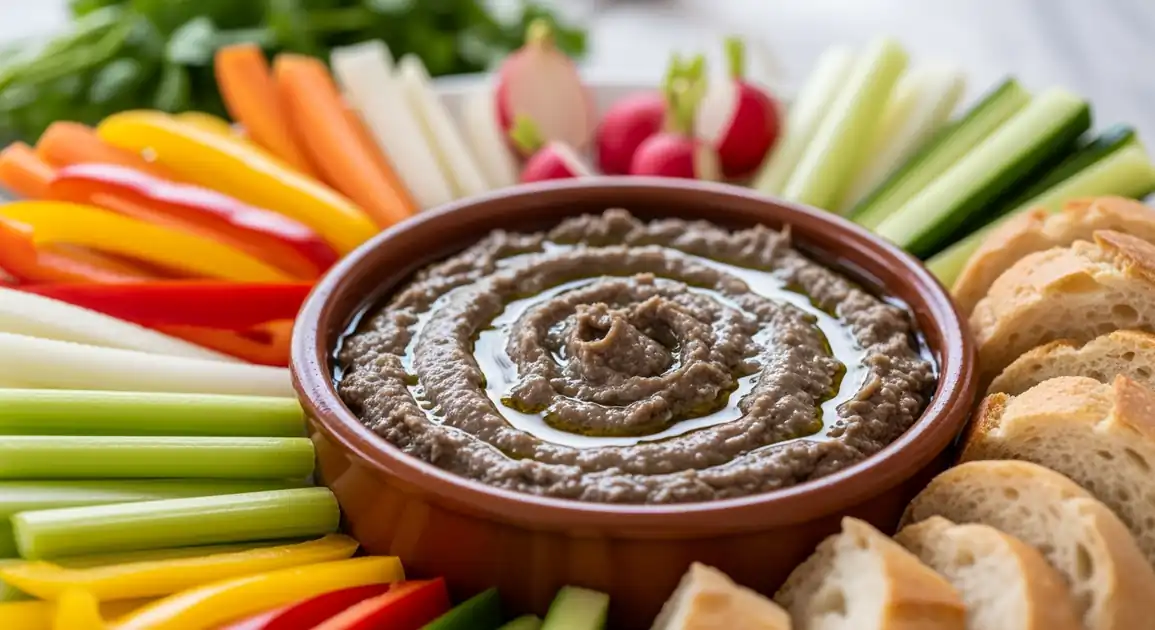Anchoïade
Anchoïade

Description
In Marseille, the vibrant heart of Provence, Anchoïade is a readily available and much-loved staple. You'll find it served in numerous restaurants, especially around the Vieux Port and in the Panier district, offered in bustling markets like Noailles, and sold by local traiteurs. It's an essential taste of Marseille's strong Mediterranean identity and lively apéritif scene.
Dietary Information
Serving information
Serving style
Served in a ramekin or small bowl with local crudités (fennel, cucumber, peppers, radishes common) and bread. Often part of a larger selection of Provençal starters.
Quick facts
Restaurants: 12 PM - 2:30 PM, 7 PM - 10:30 PM. Bars: often open longer for apéritif. Markets: Mornings mainly.
Safety Tips
What to Look For
-
Served with fresh, crisp crudités
Ensures the raw vegetable component is safe and appealing. Check for any signs of wilting or sliminess.
-
Dip stored properly (refrigerated if pre-made)
Prepared Anchoïade should be kept chilled to prevent bacterial growth, especially in warm weather.
-
Purchased from a reputable source
Choose established restaurants, trusted market vendors, or quality 'traiteurs' known for good hygiene standards.
-
Balanced flavor profile
While inherently salty, it shouldn't taste overwhelmingly of salt (which can sometimes mask lower quality anchovies) or have any off/rancid notes.
What to avoid
-
Wilted, slimy, or old-looking crudités
Indicates lack of freshness and potential bacterial contamination on the raw vegetables.
-
Anchoïade left sitting out at room temperature for extended periods
Increases the risk of bacterial growth, especially in warm environments like outdoor markets.
-
An overpowering 'fishy' or ammonia-like smell
Suggests the anchovies used might not have been of good quality or the dip is past its best.
-
Establishments with visibly poor hygiene standards
General cleanliness is a good indicator of overall food safety practices.
Price information
Price range
Budget tips
- Enjoying Anchoïade as part of an 'apéro' at a bar can sometimes be cheaper than a restaurant starter.
- Check prices at market stalls for potentially better value takeaway options.
- Restaurants in the main Vieux Port tourist strip might be pricier than those in adjacent streets or neighborhoods like Le Panier.
Value indicators
- Served with very fresh, seasonal vegetables from local markets.
- Robust garlic flavor, typical of Marseille cuisine.
- Good quality anchovies used, indicated by balanced saltiness.
- Often served generously.
Where to Find This Dish
Vieux Port (Old Port)
Numerous restaurants surrounding the harbor offer Anchoïade, catering to both locals and tourists.
Old Port waterfront, Restaurants along Quai du Port / Quai de Rive Neuve
Lunch, Dinner (Apéritif)
Le Panier
Marseille's oldest neighborhood has charming squares with restaurants and cafes serving local specialties like Anchoïade.
Place de Lenche, La Vieille Charité
Lunch, Apéritif
Marché de Noailles (Capucin Market)
Vibrant market where you might find stalls selling ingredients or prepared Anchoïade, reflecting Marseille's diverse influences.
Canebière (nearby), Noailles metro station
Market hours (typically mornings)
Cours Julien / La Plaine
Bohemian area with many bars and restaurants offering apéritif platters that often include Anchoïade.
Cours Julien square, Place Jean Jaurès (La Plaine)
Apéritif, Dinner
Vendor Tips
- Look for restaurants popular with locals for more authentic preparations.
- Ask if the Anchoïade is 'fait maison' (homemade).
- Don't hesitate to ask for more bread if needed.
- Be aware that Marseille versions can be quite potent with garlic.
How to Order
Regional Variations
-
Strong Garlic Presence
(Présence Forte d'Ail)
Marseille preparations often feature a generous, assertive amount of garlic.
-
Use of Local Anchovies
(Utilisation d'Anchois Locaux)
Some producers might emphasize the use of anchovies sourced from the Mediterranean.
Cultural context
History
The roots of Anchoïade lie in the traditional cuisine of Provence, utilizing readily available preserved anchovies, a staple for coastal communities and fishermen. While sometimes linked anecdotally to ancient Roman fish sauces like garum, modern Anchoïade is distinct. It represents simple, flavorful peasant fare elevated to a beloved regional specialty, embodying the sun-drenched flavors of the Mediterranean and the importance of the apéritif ritual in Southern France.
Local significance
Anchoïade is a taste of Marseille's maritime heritage and its position as a gateway to Provence. It's part of the city's strong identity and love for robust flavors.
Eating customs
- Often the first item served during an apéritif.
- Shared amongst the table.
- Paired typically with Pastis (anise liqueur) or local Rosé wine.